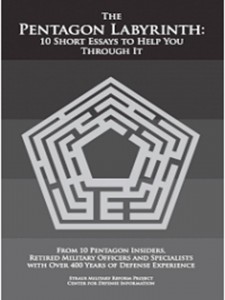It is my pleasure to announce the publication of The Pentagon Labyrinth: 10 Short Essays to Help You Through It. This is a short pamphlet of less than 150 pages and is available at no cost in E-Book PDF format, as well as in hard copy from links on this page as well as here and here. Included in the menu below are download links for a wide variety of supplemental/supporting information (much previously unavailable on the web) describing how notions of combat effectiveness relate to the basic building blocks of people, ideas, and hardware/technology; the nature of strategy; and the dysfunctional character of the Pentagon’s decision making procedures and the supporting role of its accounting shambles.
Chuck Spinney
The Blaster
This pamphlet aims to help both newcomers and seasoned observers learn how to grapple with the problems of national defense. Intended for readers who are frustrated with the superficial nature of the debate on national security, this handbook takes advantage of the insights of ten unique professionals, each with decades of experience in the armed services, the Pentagon bureaucracy, Congress, the intelligence community, military history, journalism and other disciplines. The short but provocative essays will help you to:
- identify the decay – moral, mental and physical – in America’s defenses,
- understand the various “tribes” that run bureaucratic life in the Pentagon,
- appreciate what too many defense journalists are not doing, but should,
- conduct first rate national security oversight instead of second rate theater,
- separate careerists from ethical professionals in senior military and civilian ranks,
- learn to critique strategies, distinguishing the useful from the agenda-driven,
- recognize the pervasive influence of money in defense decision-making,
- unravel the budget games the Pentagon and Congress love to play,
- understand how to sort good weapons from bad – and avoid high cost failures, and
- reform the failed defense procurement system without changing a single law.
The handbook ends with lists of contacts, readings and Web sites carefully selected to facilitate further understanding of the above, and more.
Select Reviews:
A blog run by Bryan Rahija at the Project on Government Oversight (POGO) seeks to answer some basic questions about the content of the book. I attempt to start the discussion responding to the question “What's the one passage of the book that you'd ask the Secretary of Defense to read?” Find the POGO Blog at http://pogoblog.typepad.com/pogo/2011/03/navigating-the-pentagon-labyrinth-six-questions-with-winslow-wheeler.html.
Select press:
Download the whole book in .pdf format, or find individual essays and supplemental materials below.
- Preface
- About the Authors
- Essays:
- Why is this Handbook Necessary? Franklin C. Spinney (this essay is a variation of the Domestic Roots of Perpetual War)
- Penetrating the Pentagon. George Wilson
- Learning about Defense. Bruce I. Gudmundsson
- Congressional Oversight. Willing and Able or Willing to Enable? Winslow T. Wheeler
- Careerism. Col. GI Wilson, USMC, ret.
- Confused Alarms of Struggle and Flight: A Primer for Assessing Defense Strategy in the post-Iraq World. Col. Chet Richards, USAF, ret.
- Follow the Money. Andrew Cockburn
- Decoding the Defense Budget. Winslow T. Wheeler
- Evaluating Weapons: Sorting the Good from the Bad. Pierre M. Sprey
- Developing, Buying and Fielding Superior Weapon Systems. Thomas Christie
- “Genghis John.” Proceedings of the U. S. Naval Institute. July 1997, pp. 42-47.
- Statement before the Subcommittee on National Security, Veterans Affairs and International Relations, Committee on Government Reform, US House or Representatives. June 4, 2002.
- The New QDR: The Pentagon Goes Intellectually AWOL. CounterPunch. February 2010.
- The JSF: One More Card in the House. Proceedings of the Naval Institute. August 2000.
- Defense Death Spiral, September 1998.
- Porkbarrels & Budgeteers: What Went Wrong with the Defense Review. September, 1997.
- Defense Time Bomb; Background: F-22/JSF Case Study Hypothetical Escape Option. March 1996.
- Three Reasons Why the ATF Should Not Be Approved for Engineering and Manufacturing Development. July 23, 1991.
- Defense Power Games. October 1990.
- If We Can Keep It: A National Security Manifesto for the Next Administration
- Shattering Illusions: A National Security Strategy for 2009-2017
- Systems Analysis Problems of Limited War
- M-16 Rifle Case Study
- Notes on Close Air Support
- Combat Effectiveness Considerations in Designing Close Support Fighters
- Coming to Grips with Effectiveness in Rifles
- Promise and Reality: Beyond Visual Range (BVR) Air-To-Air Combat
- “Nothing’s too good for our boys!” — Why Can’t DOD give us Quality and Quantity?
- Comparing the Effectiveness of Air-to-Air Fighters: F-86 to F-18
- Small Arms Weapons Systems Analysis: A Review and Evaluation
- Comparing the Effectiveness of Current Tanks
- The Terrible Cost of Not Testing with Real Weapons, Shooting at Real Targets
- Today’s OT&E: Abuses and Remedies
- The Evaluation of Small Arms Effectiveness Criteria: Volume 1
- America’s Defense Meltdown, Chapter 2: Shattering Illusions
- America’s Defense Meltdown, Chapter 3: Leading the Human Dimension Out of a Legacy of Failure
- America’s Defense Meltdown, Chapter 7: Reversing the Decay of American Air Power
- Combat Lessons from Lebanon and the Falklands
- Coming to Grips with Effectiveness in Rifles
- Land-Based Tactical Aviation
- Letting Combat Results Shape the Next Air-to-Air Missile
- “Nothing’s too good for our boys!” — Why Can’t DOD give us Quality and Quantity?
- Promise and Reality: Beyond Visual Range (BVR) Air-To-Air Combat
- Radar: shield or target?
- Strategic Bombing: Always a Myth
- The “Military Reform” Debate: Directions for the Defense Establishment for the Remainder of the Century




